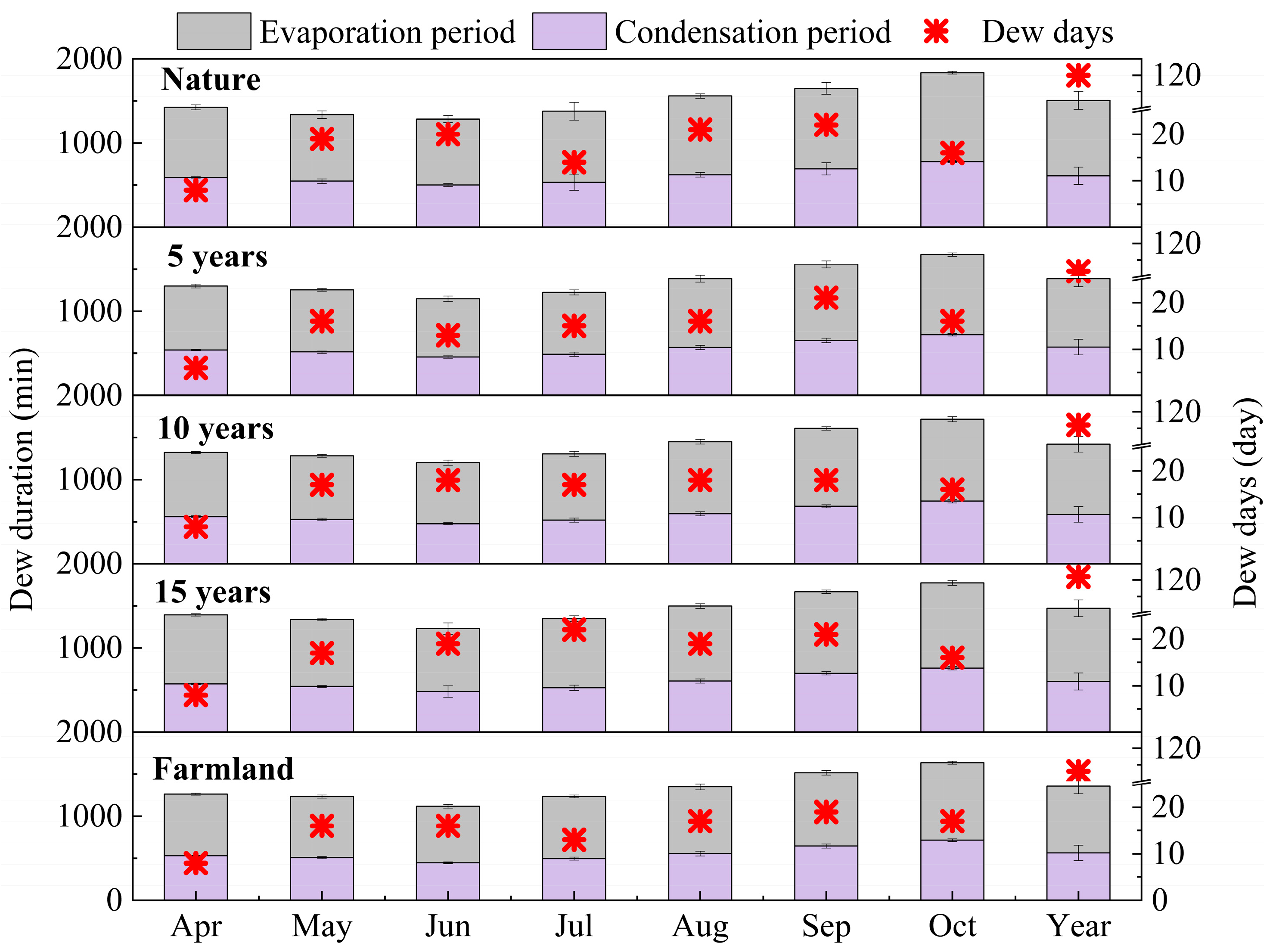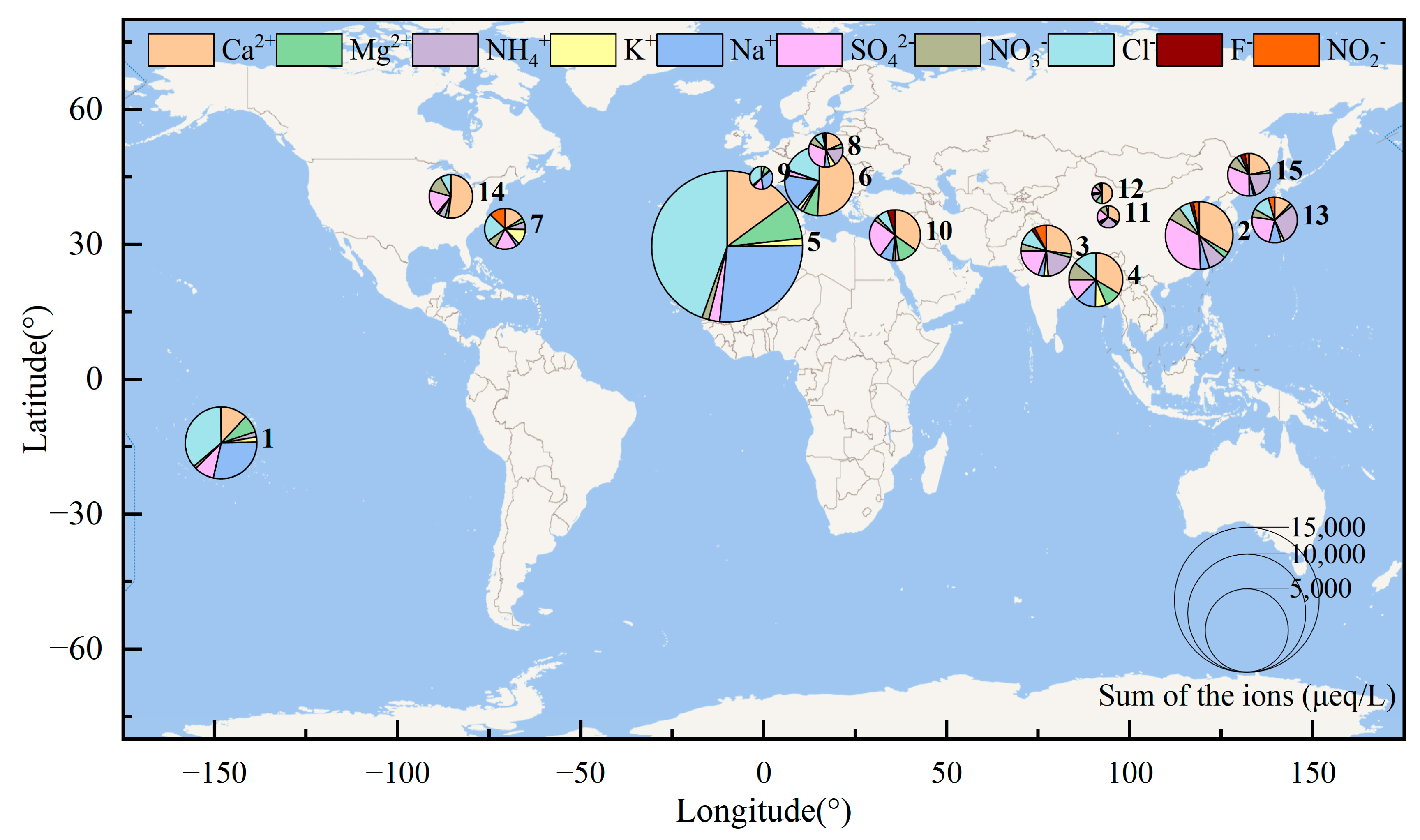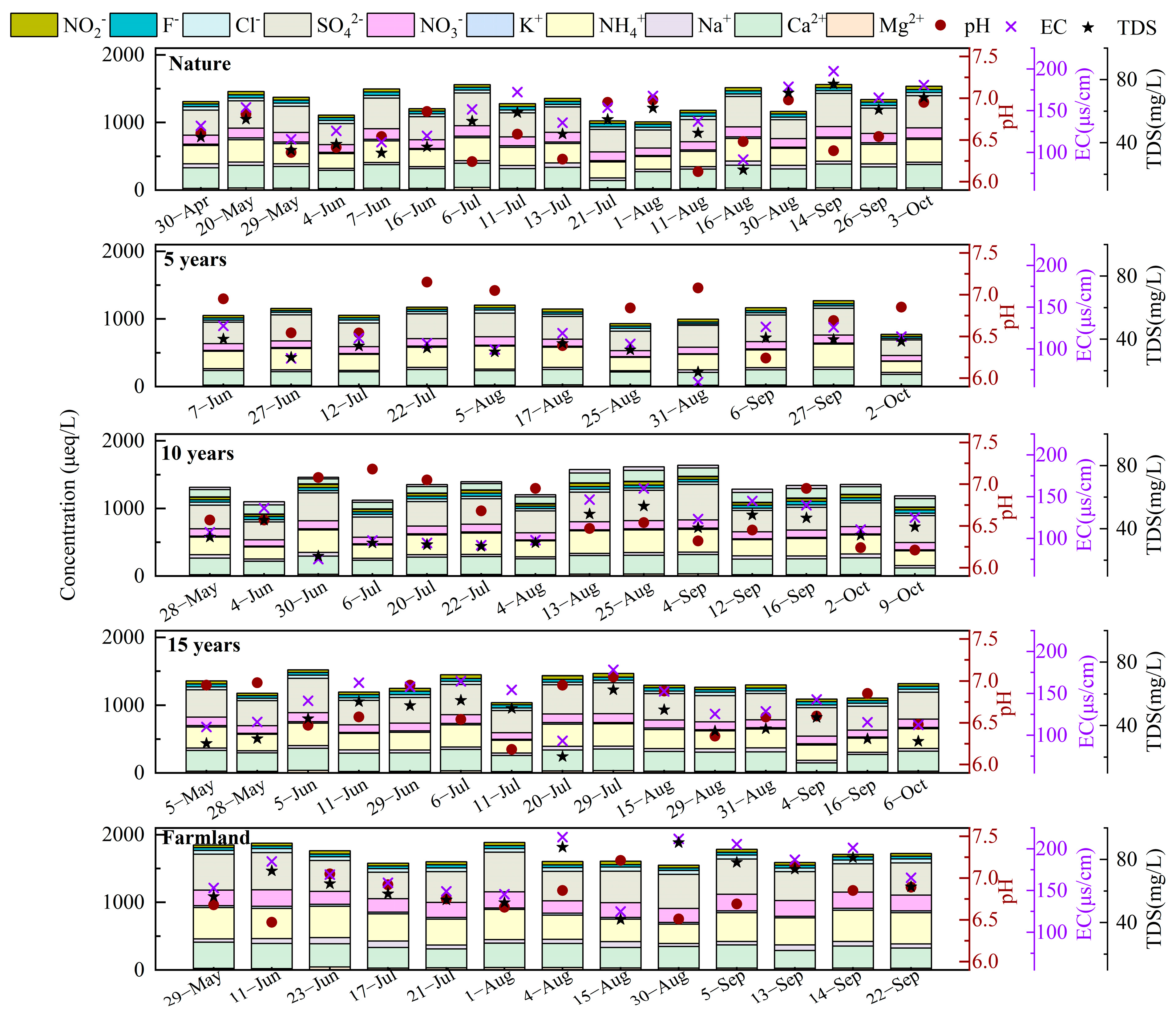Does Marsh Restoration Have an Impact on Dew?
Abstract
1. Introduction
2. Materials and Methods
2.1. Monitoring Site
2.2. Typical Plants
2.3. Dew Monitoring Method
2.4. Sample Collection and Analysis
3. Results and Discussion
3.1. Dew Frequency and Duration
3.2. Dew intensity and Amount
3.3. Dew Chemical Characteristics
- Ref. [42], Tikehau, Frech.
- Ref. [43], Nanjing, China.
- Ref. [35], New Delhi, India.
- Ref. [44], Bhola, Bangladesh.
- Ref. [41], Mirleft, Morocco.
- Ref. [37], Zadar, Croatia.
- Ref. [39], Santiago, Chile.
- Ref. [38], Wroclaw, Poland.
- Ref. [45], Bordeaux, Frech.
- Ref. [46], Amman, Jodan.
- Ref. [47], Fayetteville, US.
- Ref. [48], Indianapolis, US.
- Ref. [40], Yokohama, Japan.
- Ref. [49], Warren, US.
- This study, Sanjiang, China.
4. Conclusions
Author Contributions
Funding
Data Availability Statement
Acknowledgments
Conflicts of Interest
References
- Sun, M.; Tian, X.; Zou, Y.; Jiang, M. Ecological aesthetic assessment of a rebuilt wetland restored from farmland and management implications for National Wetland Parks. PLoS ONE 2019, 14, e0223661. [Google Scholar] [CrossRef] [PubMed]
- Xu, Y.Y.; Yan, B.X.; Luan, Z.Q.; Zhu, H. Dewfall variation by large-scale reclamation in Sanjiang Plain. Wetlands 2012, 32, 783–790. [Google Scholar] [CrossRef]
- CCTV Network. China Has Achieved Remarkable Results in Wetland Protection. 2022. Available online: https://news.cctv.com/2022/11/05/ARTI1RzicYc2G5zjPCYKen6r221105.shtml (accessed on 5 November 2022).
- Yasutake, D.; Yokoyama, G.; Maruo, K.; Wu, Y.R.; Wang, W.Z.; Mori, M.; Kitano, M. Analysis of leaf wetting effects on gas exchanges of corn using a whole-plant chamber system. Plant Soil Environ. 2018, 64, 233–239. [Google Scholar] [CrossRef]
- Chavez-Sahagun, E.; Andrade, J.L.; Zotz, G.; Reyes-Garcia, C. Dew can prolong photosynthesis and water status during drought in some epiphytic bromeliads from a seasonally dry tropical forest. Trop. Conserv. Sci. 2019, 12, 1–11. [Google Scholar] [CrossRef]
- Munne-Bosch, S.; Nogues, S.; Alegre, L. Diurnal variations of photosynthesis and dew absorption by leaves in two evergreen shrubs growing in Mediterranean field conditions. New Phytol. 1999, 144, 109–119. [Google Scholar] [CrossRef]
- Barradas, V.L.; Glez-Medellin, M.G. Dew and its effect on two heliophile understorey species of a tropical dry deciduous forest in Mexico. Int. J. Biometeorol. 1999, 43, 1–7. [Google Scholar] [CrossRef]
- Liu, M.Z.; Cen, Y.; Wang, C.D.; Gu, X.; Bowler, P.; Wu, D.X.; Zhang, L.; Jiang, G.M.; Beysens, D. Foliar uptake of dew in the sandy ecosystem of the Mongolia Plateau: A life-sustaining and carbon accumulation strategy shared differently by C3 and C4 grasses. Agr. Forest Meteorol. 2020, 287, 107941. [Google Scholar] [CrossRef]
- Carmichael, M.J.; White, J.C.; Cory, S.T.; Berry, Z.C.; Smith, W.K. Foliar water uptake of fog confers ecophysiological benefits to four common tree species of southeastern freshwater forested wetlands. Ecohydrology 2020, 13, e2240. [Google Scholar] [CrossRef]
- Hayes, M.A.; Chapman, S.; Jesse, A.; O’Brien, E.; Langley, J.A.; Bardou, R.; Devaney, J.; Parker, J.D.; Cavanaugh, K.C. Foliar water uptake by coastal wetland plants: A novel water acquisition mechanism in arid and humid subtropical mangroves. J. Ecol. 2020, 108, 2625–2637. [Google Scholar] [CrossRef]
- Kool, D.; Agra, E.; Drabkin, A.; Duncan, A.; Fendinat, P.P.; Leduc, S.; Lupovitch, G.; Nambwandja, A.N.; Ndilenga, N.S.; Thi, T.N.; et al. The overlooked non-rainfall water input sibling of fog and dew: Daily water vapor adsorption on a Nara hummock in the Namib sand sea. J. Hydrol. 2021, 598, 126420. [Google Scholar] [CrossRef]
- Gałek, G.; Sobik, M.; Błaśa, M.; Polkowska, Ż.; Cichała-Kamrowska, K. Dew formation and chemistry near a motorway in Poland. Pure Appl. Geophys. 2011, 169, 1053–1066. [Google Scholar] [CrossRef]
- Odeh, I.; Arar, S.; Al-Hunaiti, A.; Sa’aydeh, H.; Hammad, G.; Duplissy, J.; Vuollekoski, H.; Korpela, A.; Petaja, T.; Kulmala, M.; et al. Chemical investigation and quality of urban dew collections with dust precipitates. Environ. Sci. Pollut. Res. 2017, 24, 12312–12318. [Google Scholar] [CrossRef] [PubMed]
- Rubio, M.A.; Lissi, E.; Villena, G. Nitrite in rain and dew in Santiago city, Chile. Its possible impact on the early morning start of the photochemical smog. Atmos. Environ. 2002, 36, 293–297. [Google Scholar] [CrossRef]
- Wesely, M.L.; Sisterson, D.L.; Jastrow, J.D. Observations of the chemical properties of dew on vegetation that affect the dry deposition of SO2. J. Geophys. Res. 1990, 95, 7501–7514. [Google Scholar] [CrossRef]
- Liu, Y.; Li, J.; Yan, D.D.; Chen, L.; Li, M.; Luan, Z.Q. Typical vegetation dynamics and hydrological changes of Dongting Lake wetland from 1985 to 2020. Ecohydrol. Hydrobiol. 2023. [Google Scholar] [CrossRef]
- Yu, R.H.; Zhang, Z.Z.; Lu, X.X.; Chang, I.-S.; Liu, T.X. Variations in dew moisture regimes in desert ecosystems and their influencing factor. Wires. Water 2020, 7, e1482. [Google Scholar] [CrossRef]
- Xie, S.; Yan, D.; Li, J.; Liu, Y.; Sheng, Y.; Luan, Z. GEE-Based Spatial-Temporal Dynamics in a Ramsar Wetland, Honghe National Nature Reserve, Northeast China from 1985 to 2021. Land 2022, 11, 2137. [Google Scholar] [CrossRef]
- Yan, D.D.; Luan, Z.Q.; Xu, D.D.; Xue, Y.Y.; Shi, D. Modeling the Spatial Distribution of Three Typical Dominant Wetland Vegetation Species’ Response to the Hydrological Gradient in a Ramsar Wetland, Honghe National Nature Reserve, Northeast China. Water 2020, 12, 2041. [Google Scholar] [CrossRef]
- Xu, Y.Y.; Jia, C.Z.; Liu, H.Z. Dew Evaporation Amount and Its Influencing Factors in an Urban Ecosystem in Northeastern China. Water 2022, 14, 2428. [Google Scholar] [CrossRef]
- Xu, Y.Y.; Zhu, H.; Tang, J.; Lin, Y.Z. Chemical compositions of dew and scavenging of particles in Changchun, China. Adv. Meteorol. 2015, 2015, 104048. [Google Scholar] [CrossRef]
- Zhuang, Y.L.; Zhao, W.Z. Dew formation and its variation in Haloxylon ammodendron plantations at the edge of a desert oasis, northwestern China. Agric. Forest Meteorol. 2017, 247, 541–550. [Google Scholar] [CrossRef]
- Guo, X.N.; Zha, T.S.; Jia, X.; Wu, B.; Feng, W.; Xie, J.; Gong, J.N.; Zhang, Y.Q.; Peltola, H. Dynamics of dew in a cold desert-shrub ecosystem and its abiotic controls. Atmosphere 2016, 7, 32. [Google Scholar] [CrossRef]
- Li, H.Y.; Han, C.T.; Yang, Y.; Chen, R.S. Formation and variations of dew and hoarfrost in the Hulu Catchment on Northeast Qinghai-Tibet Plateau, China. J. Hydrol-Reg. Stud. 2022, 42, 101179. [Google Scholar] [CrossRef]
- Hanisch, S.; Lohrey, C.; Buerkert, A. Dewfall and its ecological significance in semi-arid coastal south-western Madagascar. J. Arid Environ. 2015, 121, 24–31. [Google Scholar] [CrossRef]
- Aguirre-Gutiérrez, C.A.; Holwerda, F.; Goldsmith, G.R.; Delgado, J.; Yepez, E.; Carbajal, N.; Escoto-Rodríguez, M.; Arredondo, J.T. The importance of dew in the water balance of a continental semiarid grassland. J. Arid Environ. 2019, 168, 26–35. [Google Scholar] [CrossRef]
- Pan, Y.X.; Wang, X.P.; Zhang, Y.F.; Hu, R. Dew formation characteristics at annual and daily scale in xerophyte shrub plantations at Southeast margin of Tengger desert, Northern China. Ecohydrology 2018, 11, e1968. [Google Scholar] [CrossRef]
- Jia, Z.F.; Zhao, Z.Q.; Zhang, Q.Y.; Wu, W.C. Dew yield and its influencing factors at the western edge of Gurbantunggut Desert, China. Water 2019, 11, 733. [Google Scholar] [CrossRef]
- Hao, X.M.; Li, C.; Guo, B.; Ma, J.X.; Ayup, M.; Chen, Z.S. Dew formation and its long-term trend in a desert riparian forest ecosystem on the eastern edge of the Taklimakan Desert in China. J. Hydrol. 2012, 472–473, 90–98. [Google Scholar] [CrossRef]
- Yokoyama, G.; Yasutake, D.; Wang, W.Z.; Wu, Y.R.; Feng, J.J.; Dong, L.L.; Kimura, K.; Marui, A.; Hirota, T.; Kitano, M.; et al. Limiting factor of dew formation changes seasonally in a semiarid crop field of northwest China. Agric. Forest Meteorol. 2021, 311, 108705. [Google Scholar] [CrossRef]
- Jia, Z.F.; Wang, Z.; Wang, H. Characteristics of dew formation in the semi-arid loess plateau of central Shaanxi Province, China. Water 2019, 11, 126. [Google Scholar] [CrossRef]
- Meng, Y.; Wen, X.F. Characteristics of dew events in an arid artificial oasis cropland and a sub-humid cropland in China. J. Arid Land. 2016, 8, 399–408. [Google Scholar] [CrossRef]
- Khalil, M.M.; Kara-Ali, A.; Assad, M. Potential of harvesting water from fog and dew water over semi-arid and arid regions in Syria. Water Supply 2021, 22, 874. [Google Scholar] [CrossRef]
- Wang, X.; Gao, Z.Y.; Wang, Y.K.; Wang, Z.; Jin, S.S. Dew measurement and estimation of rain-fed jujube (Zizyphys jujube Mill) in a semi-arid loess hilly region of China. J. Arid. Land 2017, 9, 547–557. [Google Scholar] [CrossRef]
- Zhang, Q.; Wang, S.; Yang, F.L.; Yue, P.; Yao, T.; Wang, W.Y. Characteristics of dew formation and distribution, and its contribution to the surface water budget in a semi-arid region in China. Bound.-Lay. Meteorol. 2015, 154, 317–331. [Google Scholar] [CrossRef]
- Nath, S.; Yadav, S. A comparative study on fog and dew water chemistry at New Delhi, India. Aerosol Air Qual. Res. 2018, 18, 26–36. [Google Scholar] [CrossRef]
- Lekouch, I.; Mileta, M.; Muselli, M.; Milimouk-Melnytchouk, I.; Sojat, V.; Kabbachi, B.; Beysens, D. Comparative chemical analysis of dew and rain water. Atmos. Res. 2010, 95, 224–234. [Google Scholar] [CrossRef]
- Polkowska, Ż.; Błaś, M.; Klimaszewska, K.; Sobik, M.; Małek, S.; Namieśnik, J. Chemical characterization of dew water collected in different geographic regions of Poland. Sensors 2008, 8, 4006–4032. [Google Scholar] [CrossRef]
- Rubio, M.A.; Lissi, E.; Villena, G. Factors determining the concentration of nitrite in dew from Santiago, Chile. Atmos. Environ. 2008, 42, 7651–7656. [Google Scholar] [CrossRef]
- Okochi, H.; Kajimito, T.; Arai, Y.; Igawa, M. Effect of acid deposition on urban dew chemistry in Yokohama, Japan. Bull. Chem. Soc. Jpn. 1996, 69, 3355–3365. [Google Scholar] [CrossRef]
- Lekouch, I.; Muselli, M.; Kabbachi, B.; Ouazzani, J.; Melnytchouk-Milimouk, I.; Beysens, D. Dew, fog, and rain as supplementary sources of water in south-western Morocco. Energy 2011, 36, 2257–2265. [Google Scholar] [CrossRef]
- Muselli, M.; Clus, O.; Ortege, P.; Milimouk, I.; Beysens, D. Physical, chemecal and biological characteristics of dew and rainwater during the dry season of tropical island. Atmosphere 2021, 12, 69. [Google Scholar] [CrossRef]
- Hong, L.; Zhu, B.; Yu, X.N.; Shi, S.S.; Chen, K. Chemical composition of dew water at a suburban site in Nanjing, China, during the 2016–2017 winter. Atmos. Environ. 2019, 211, 226–233. [Google Scholar] [CrossRef]
- Shohel, M.; Simol, H.A.; Reid, E.; Reid, J.S.; Salam, A. Dew water chemical composition and source characterization in the IGP outflow location (coastal Bhola, Bangladesh). Air Qual. Atmos. Health 2017, 10, 981–990. [Google Scholar] [CrossRef]
- Beysens, D.; Ohayon, C.; Muselli, M.; Clus, O. Chemical and biological characteristics of dew and rain water in an urban coastal area (Bordeaux, France). Atmos. Environ. 2006, 40, 3710–3723. [Google Scholar] [CrossRef]
- Jiries, A. Chemical composition of dew in Amman, Jordan. Atmos. Res. 2001, 57, 261–268. [Google Scholar] [CrossRef]
- Wagner, G.H.; Steele, K.F. Dew and frost chemistry at a Midcontinent site, United States. J. Geophys. Res. 1992, 18, 20591–20597. [Google Scholar] [CrossRef]
- Foster, J.R.; Pribush, R.; Carter, B.H. The chemistry of dew and frosts in Indianapolis, Indiana. Atmos. Environ. 1990, 24, 2229–2236. [Google Scholar] [CrossRef]
- Mulawa, P.A.; Cadle, S.H.; Lipari, F.; Carolina, C.; Vandervennet, R.T. Urban dew: Its composition and influence on dry deposition rates. Atmos. Environ. 1986, 20, 1389–1396. [Google Scholar] [CrossRef]
- Wang, M.G.; Wang, M.; Yang, L.; Yang, T.; Li, J.J.; Chen, Y.M. Distribution characteristics and genesis of iron and manganese ions in groundwater of Eastern Sanjiang Plain, China. Water 2023, 15, 2068. [Google Scholar] [CrossRef]
- Maruyama, M.; Kuwagata, T.; Watanabe, T. Observations on dew formation in the rice canopy and its simulation using a multilayer microclimate model. J. Agr. Meteorol. 2023, 79, 28–37. [Google Scholar] [CrossRef]







| Sites | Marsh Restoration Period | Typical Plant | Average Annual Water Depth (cm) | Total Plant Cover (%) | Average Plant Height (cm) |
|---|---|---|---|---|---|
| 46°32′ N 132°09′ E | 0 | soybean | 0 | 72 | 75 |
| 45°96′ N, 132°08′ E | 5 years | Artemisia stolonifera | 5 | 67 | 45 |
| 45°75′ N, 132°42′ E | 10 years | Carex angustifolia | 15 | 75 | 55 |
| 45°51′ N, 132°61′ E | 15 years | Carex angustifolia—Carex lasiocarpa | 24 | 85 | 58 |
| 47°48′ N, 133°58′ E | nature | Carex lasiocarpa | 32 | 90 | 52 |
| Site | Surface Layer | Study Period | Dew Days (day/y) | Average Duration (h) | Dew Intensity (mm/cm2·d) | Dewfall (mm/y) | Proportion of Precipitation in the Same Period (%) | Reference |
|---|---|---|---|---|---|---|---|---|
| Duolun County, Inner Mongolia, China (116°31.75′ E, 42°4.36′ N) | Sandland | 2013–2015 (June–October) | 82–116 | 8.3 | 0.15 | 6.18–9.4 | - | [8] |
| Badain Jaran Desert, China (100°07′ E, 39°21′ N) | Shrub | 2013 (June–October) | 118 | 7.6 | 0.13 | 16.1 | 16.7% | [22] |
| Ningxia, China (107°13′ E, 37°42′ N) | 2012.6–2012.10 | 166 | 7.5 | 0.049 | 21.3 | 7.2% | [23] | |
| Qinghai–Tibet Plateau, China (99°50′ E–99°54′ E, 39°12′–39°17′ N) | Grass | 2016–2020 | 90–313 | >9 | 0.11 | 3–33 | 0.3–7.3% | [24] |
| Efoetsty, Madagasar (43.70° E, 24.08° S) | 2013.4–2014.9 | 323 | 14.5 | 0.16 | 58.4 | 19% | [25] | |
| Vaquerias, Mexico (101°60′ W, 21°78′ N) | 2011.1–2016.12 | 144 | 5 | 0.20 | 16.5–69 | 4.9–10.2% | [26] | |
| Tengger Desert, China (104°57′ E, 37°27′ N) | Moss crust | 2013.9–2014.8 | 128 | 20 | 0.12 | 15.3 | 8.2% | [27] |
| Gurbantuggut Desert, China (85°33′ E, 44°48′ N) | Haloxylon ammodendron | 2015–2018 | 160 | 13 | 0.10 | 12.1 | 9.1% | [28] |
| Taklimakan Desert, China (87°51′ E, 40°28′ N) | Populus | 2011.6–2011.10 | 104 | 2 | 0.12 | 17.2 | 64% | [29] |
| Baiyin City, China (104°25.4′ E, 36°25.5′ N) | Corn | 2018–2020 (April–September) | 81 | 10 | - | 7.64–11.7 | 5.4% | [30] |
| Sanyuan County, China (108°54′ E, 33°33′ N) | Wheat/corn | 2014–2016 | 180–253 | 10 | 0.09 | 28.1–43.3 | 4.3–7.8% | [31] |
| Zhangye, China (100°22′ E, 38°51′ N) | Wheat/maize | 2012.5–2012.9 | 69 | 5.0 | 0.14 | 9.9 | 9.5% | [32] |
| Luancheng, China (114°40′ E, 37°49′ N) | 2008.4–2008.9 | 128 | 5.4 | 0.16 | 20.2 | 4.1% | ||
| Sanjiang Plain, China (133°58′ E, 47°48′ N) | Carex lasiocarpa | 2022.4–2022.10 | 120 | 14.8 | 0.14 | 47.96 | 11.93% | This study |
| Sanjiang Plain, China (132°61′ E, 45°51′ N) | Carex angustifolia—Carex lasiocarpa | 122 | 14.5 | 0.13 | 44.86 | 11.81% | ||
| Sanjiang Plain, China (132°42′ E, 45°75′ N) | Carex angustifolia | 112 | 13.9 | 0.10 | 40.46 | 10.16% | ||
| Sanjiang Plain, China (132°8′ E, 45°96′ N) | Artemisia stolonifera | 103 | 13.5 | 0.08 | 38.39 | 10.55% | ||
| Sanjiang Plain, China (132°09′ E, 46°32′ N) | Soybean | 106 | 13.2 | 0.06 | 35.10 | 9.83% |
| Site | Reference | Wind Speed (m/s) | RH | Surface Layer |
|---|---|---|---|---|
| Inner Mongolia, China | [8] | <4.0 | >80% | Sandland |
| Syria | [33] | <8 | - | Sandland |
| Badain Jaran Desert, China | [22] | <4.27 | >50% | Shrubs |
| Qinghai–Tibet Plateau, China | [24] | <1.8 | >52% | Grass |
| Mizhi, China | [34] | <2.0 | >78 | Jujube |
| Loess Plateau, China | [35] | <1.5 | >80% | Farmland |
| Sanjiang, China | This study | <5.56 | >44.5 | Farmland |
| <6.40 | >42.5 | Marsh |
| Natural Marsh | 5-Year Restored Marsh | 10-Year Restored Marsh | 15-Year Restored Marsh | Farmland | ||||||||||
|---|---|---|---|---|---|---|---|---|---|---|---|---|---|---|
| Rain | Surface water | Dew | Rain | Surface water | Dew | Rain | Surface water | Dew | Rain | Surface water | Dew | Rain | Dew | |
| pH | 6.7 ± 0.4 | 6.1 ± 0.2 | 6.6 ± 0.3 | 6.9 ± 0.4 | 6.8 ± 0.3 | 6.8 ± 0.3 | 6.7 ± 0.3 | 6.6 ± 0.3 | 6.7 ± 0.3 | 6.9 ± 0.3 | 6.2 ± 0.1 | 6.7 ± 0.3 | 6.8 ± 0.2 | 6.8 ± 0.2 |
| EC (μs/cm) | 126.0 ± 11.2 | 215.0 ± 20.1 | 146.6 ± 28.6 | 95.0 ± 4.6 | 159.0 ± 5.7 | 108.0 ± 19.9 | 104.0 ± 5.6 | 168.0 ± 10.7 | 117.9 ± 10.5 | 106.0 ± 10.5 | 185.0 ± 19.3 | 137.1 ± 24.6 | 134.0 ± 11.2 | 174.7 ± 28.4 |
| TDS (mg/L) | 35.0 ± 3.7 | 212.0 ± 20.4 | 51.0 ± 14.9 | 29.0 ± 2.7 | 68.0 ± 4.7 | 34.5 ± 6.4 | 38.0 ± 3.0 | 125.0 ± 11.3 | 38.6 ± 6.3 | 42.0 ± 6.3 | 189.0 ± 22.5 | 42.2 ± 12.3 | 37.0 ± 2.4 | 67.3 ± 14.7 |
Disclaimer/Publisher’s Note: The statements, opinions and data contained in all publications are solely those of the individual author(s) and contributor(s) and not of MDPI and/or the editor(s). MDPI and/or the editor(s) disclaim responsibility for any injury to people or property resulting from any ideas, methods, instructions or products referred to in the content. |
© 2024 by the authors. Licensee MDPI, Basel, Switzerland. This article is an open access article distributed under the terms and conditions of the Creative Commons Attribution (CC BY) license (https://creativecommons.org/licenses/by/4.0/).
Share and Cite
Xu, Y.; Chen, L.; Hou, H.; Zhang, Y. Does Marsh Restoration Have an Impact on Dew? Water 2024, 16, 178. https://doi.org/10.3390/w16010178
Xu Y, Chen L, Hou H, Zhang Y. Does Marsh Restoration Have an Impact on Dew? Water. 2024; 16(1):178. https://doi.org/10.3390/w16010178
Chicago/Turabian StyleXu, Yingying, Lei Chen, Haodong Hou, and Yachao Zhang. 2024. "Does Marsh Restoration Have an Impact on Dew?" Water 16, no. 1: 178. https://doi.org/10.3390/w16010178
APA StyleXu, Y., Chen, L., Hou, H., & Zhang, Y. (2024). Does Marsh Restoration Have an Impact on Dew? Water, 16(1), 178. https://doi.org/10.3390/w16010178






